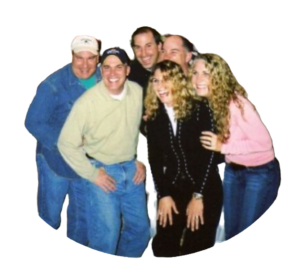When I think back on my childhood, certain images come flooding back to me. Neighborhood games of Car Ditch or Johnny Tackle, six kids making up hilarious games on long drives in the station wagon, watching my brothers jump over a cardboard box for an entire day or playing the running game in the basement while listening to Zorba the Greek. But even more than I see my memories, I hear them. And the sound is always laughter. In a family with 6 kids (all born in a span of less than 5 years), we functioned as a pack. A really fun pack. We laughed while we watched cartoons together, as we rushed through our cereal breakfast, on the school bus, in the ridiculously dangerous snow forts that we built, fishing for bluegills in the lake, and always in our beds at night. We laughed the loudest at the dinner table and hardest at church where we were not allowed to laugh…not even a little. Being #4 in the sibling ranking there was a big adjustment when – one by one – my older brothers left the family house to go off to school or to new cities or to get married. What I missed most was the laughter, and what I loved most was the laughter when they came back home.

I can’t remember exactly what was so funny. We weren’t anything like big joke tellers or practical jokers. But we all developed the ability to find the funny in a story and we all became storytellers by necessity. With so many voices in the house, we couldn’t get away with basic conversation. And because of that, we learned to observe life in a way that made us see through the mundane into the funny. To set ourselves apart from one another, we had to translate our day-to-day world into something interesting and humor was how we made that happen.
Our youngest brother Marty felt the pressure to amuse most particularly. Sitting around a dinner table with five older siblings and two funny parents, he knew it was imperative to tell a great story or no one was going to listen. The expectations were high that the story be entertaining. And the “I care” factor was very low. By that I mean that nobody really cared about what went on in each others day – who we played with at recess, who learned what in social studies, what songs we were playing in band. Those sorts of discussion topics were for small-family people.
If one of us had an art project due that day, it was no big deal. Probably everyone sitting at the table had done the exact same art project – a family of puppets with Styrofoam ball heads – at some point in his or her life. We had to come up with a good way to tell the story or we’d be dead. No one would listen and we’d would never get our moment at the table.
What about my Styrofoam puppets was funny? How I dropped them all in the snow getting off the bus? How I used toilet paper for puppet clothes? Or how mom bought 3 small Styrofoam balls and 1 huge one creating a gigantic head on one of the puppets?
So we all listened and learned about what was funny from our family. Steadily, we developed a collective sense of humor that defined us as DiFriscos and gave us great confidence when we went out and found ourselves in front of a larger audience. We learned that observational humor is funny – whining is not. Making fun of yourself…..funny – making fun of your mother…. definitely not funny!
We absorbed how to pace a story and turn a phrase, where embellishment and colorful descriptions worked, which details to keep in and which could be edited out. And, of course, we learned the value of a having a point – a punch line – to the story.
Our mother was a wonderful storyteller, and very funny. People would occasionally say to us, “you guys think everything is funny”. Well, it was to us. And yes, we definitely laughed at one another’s expense. The family heckled each other about ugly pants, bad hair, and questionable decisions, which continues to this day. And, of course, there were favorite targets outside the family who made us die laughing.
The close-talking second cousin who targeted one of us on every occasion, running away when our deaf grandmother wanted to talk to us on the phone, our housekeeper who baked the world’s worst coffee cake, the drunk parish priest with the horrible body odor and our neighbor lady who tattled to our mom because she thought “dork” was a swear word. All still funny!
But mainly we laughed at ourselves – our lame jobs rolling plastic forks and napkins in saran wrap or delivering newspapers from our shared bike, our mediocre grades, ugly cars, or missed cheerleading opportunities, the usual trials and tribulations of the teen years.
I remember paying attention to details during the day so that I could tell a good story at the dinner table that night. If I wanted my moment at the table, my experience couldn’t just be a little bad, I had to roast spectacularly. We managed to avoid a lot of the predictable teen awkwardness because we could reconstruct our lives to be more entertaining by highlighting the funny. Failing to make the cheerleading team, not funny. Failing to make the cheerleading team because an unfortunate misstep over my way-too-big new shoes followed by a face plant, funny!
My brother Vinnie in serious condition in the hospital, not funny. But Vinnie in his hospital gown lying flat on his back, quietly asking us visiting siblings to walk to the end of the bed to make sure that his balls weren’t showing, very funny.
These days, I clearly see the importance of being able to tell a story and to see the fun in a situation when it comes to problem-solving, continuous improvement, working as a team, and creating joy at work.

Organize the story, filter out the noise and unnecessary details, swiftly move through the timeline, set yourselves up for a great ending and create bonds with joy and laughter along the way.
There’s nothing necessarily fun about sagging revenues, out of control expenses, lost customers, poor quality, burned out employees – but it truly is what you make of it. And I think that we have the obligation to make the best of it.
In many ways, structured problem-solving is not only a skill but a filter through which to view the world. Life is full of moments of surprise, monotony, confusion, panic, joy, mistakes, humility, and self-doubt. You can choose to observe these moments as an unchangeable status quo, or you can engage and participate with the power of continuous improvement and create a better reality. Knowing how to recognize, confront and improve situations can turn the serious into the exciting and the slog into the sprint. And along the way, you will realize that you’ve created bonds through shared success and through the sheer magic of teamwork.








